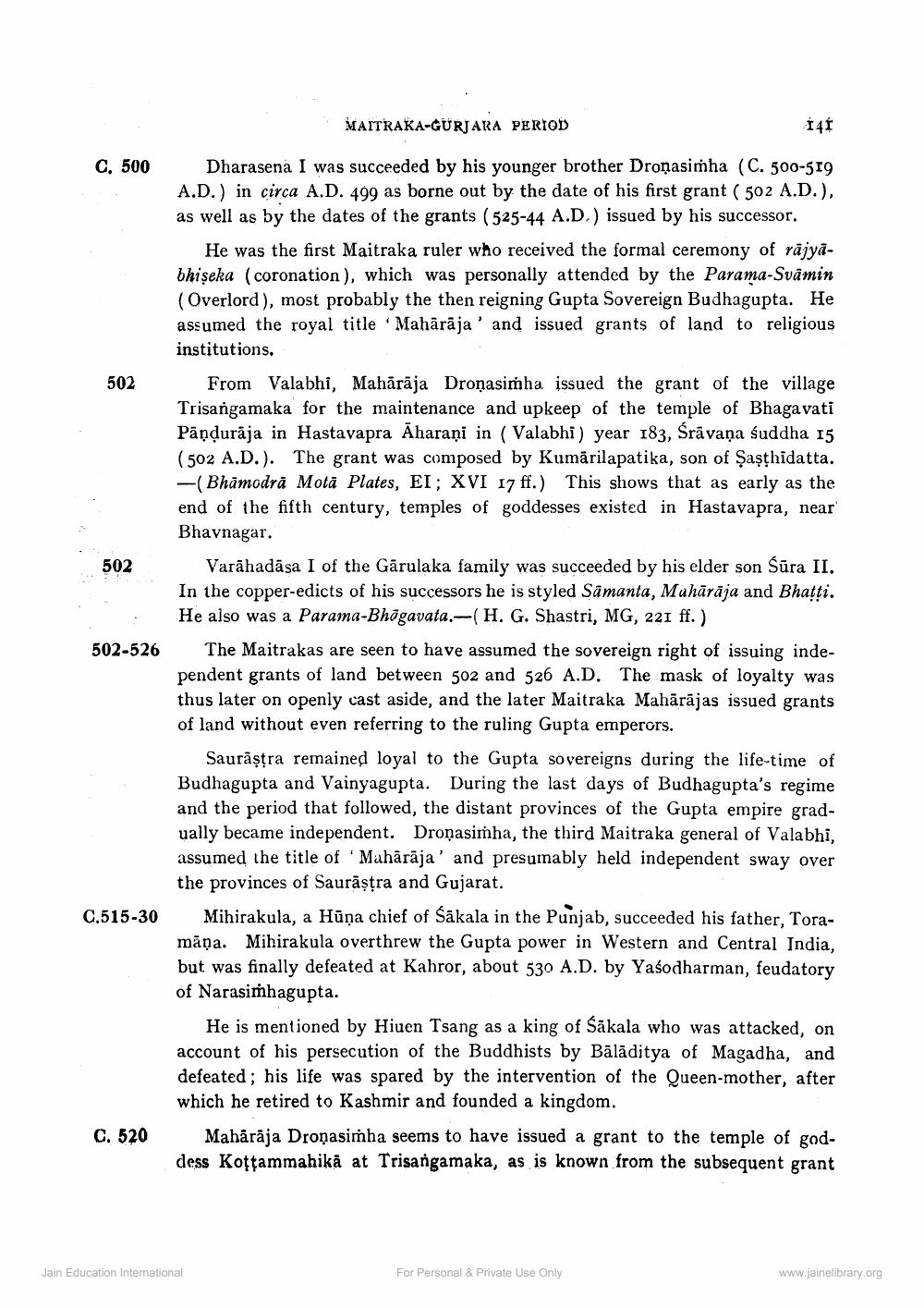________________
MAITRAKA-GURJARA PERIOD
141
C. 500
502
502-526
Dharasena I was succeeded by his younger brother Dronasimha (C. 500-519 A.D.) in circa A.D. 499 as borne out by the date of his first grant ( 502 A.D.), as well as by the dates of the grants (525-44 A.D.) issued by his successor.
He was the first Maitraka ruler who received the formal ceremony of rājyabhiseka (coronation), which was personally attended by the Parama-Svāmin (Overlord), most probably the then reigning Gupta Sovereign Budhagupta. He assumed the royal title Mahārāja' and issued grants of land to religious institutions.
From Valabhi, Mahārāja Droņasimha issued the grant of the village Trisangamaka for the maintenance and upkeep of the temple of Bhagavati Pāņdurāja in Hastavapra Āharaņi in (Valabhi) year 183, Srāvaņa śuddha 15 (502 A.D.). The grant was composed by Kumārilapatika, son of Şaşthidatta. -(Bhāmodrā Motā Plates, EI; XVI 17 ff.) This shows that as early as the end of the fifth century, temples of goddesses existed in Hastavapra, near Bhavnagar.
Varāhadāsa I of the Gārulaka family was succeeded by his elder son Śūra II. In the copper-edicts of his successors he is styled Samanta, Mahārāja and Bhatti. He also was a Parama-Bhāgavata.-(H. G. Shastri, MG, 221 ff.)
The Maitrakas are seen to have assumed the sovereign right of issuing independent grants of land between 502 and 526 A.D. The mask of loyalty was thus later on openly cast aside, and the later Maitraka Mahārājas issued grants of land without even referring to the ruling Gupta emperors.
Saurāṣtra remained loyal to the Gupta sovereigns during the life-time of Budhagupta and Vainyagupta. During the last days of Budhagupta's regime and the period that followed, the distant provinces of the Gupta empire gradually became independent. Dronasimha, the third Maitraka general of Valabhi, assumed the title of 'Mahārāja' and presurnably held independent sway over the provinces of Saurāșțra and Gujarat.
Mihirakula, a Hūņa chief of Säkala in the Punjab, succeeded his father, Toramāņa. Mihirakula overthrew the Gupta power in Western and Central India, but was finally defeated at Kahror, about 530 A.D. by Yasodharman, feudatory of Narasimhagupta.
He is mentioned by Hiuen Tsang as a king of Sākala who was attacked, on account of his persecution of the Buddhists by Bālāditya of Magadha, and defeated; his life was spared by the intervention of the Queen-mother, after which he retired to Kashmir and founded a kingdom.
Mahārāja Dronasimha seems to have issued a grant to the temple of goddess Kottammahika at Trisangamaka, as is known from the subsequent grant
C.515-30
C. 520
Jain Education Intemational
For Personal & Private Use Only
www.jainelibrary.org




